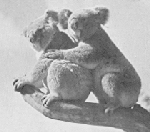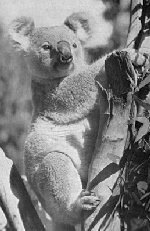 15 million years ago: Perikoala palankarinnica
15 million years ago: Perikoala palankarinnica
 10 million years ago: Litokoala kutjamarpensis
10 million years ago: Litokoala kutjamarpensis
 5 million years ago: Koobor notabilis & Koobor jimbarratti
5 million years ago: Koobor notabilis & Koobor jimbarratti
 0 million years ago: Phascolarctos cinereus & Phascolarctos
stirtoni
0 million years ago: Phascolarctos cinereus & Phascolarctos
stirtoni
T here were once several different kinds of koala -- all but one of which had died out. The earliest known member of the koala family was a browser, which lived 15 millions years ago. Evidence of a 'giant' koala, twice the size of its modern descendant, exists in fossils dating back more than 40,000 years.
 15 million years ago: Perikoala palankarinnica
15 million years ago: Perikoala palankarinnica
 10 million years ago: Litokoala kutjamarpensis
10 million years ago: Litokoala kutjamarpensis
 5 million years ago: Koobor notabilis & Koobor jimbarratti
5 million years ago: Koobor notabilis & Koobor jimbarratti
 0 million years ago: Phascolarctos cinereus & Phascolarctos
stirtoni
0 million years ago: Phascolarctos cinereus & Phascolarctos
stirtoni
 |
 |
1798, January 26: The 1st record of a koala being seen by an European, named John Price. |
 |
1803, August 21: The first detailed account of a koala was published in Sydney Gazette. | |
 |
1816: the French naturalist de Blainwill gave the koala its scientific name, Phascolarctos, from the Greek words for 'leather pouch' and 'bear'. Later, the German naturalist Goldfuss gave it the specific name cinereus, meaning 'ash-coloured', after the color of the original specimen. |
-- From: Koala Handbook by Simon Hunter --
| History of the name: "koala" | |
| I n their history of the koala, Tom Iredale and Gilbert Whitley (1934) suggest that the common name "koala" was derived from an Aboriginal dialect of eastern New South Wales. Ronald Strahan (1978) lists cullewine, koolewong, colo, colah, koolah, kaola and koala as published dialectal variations of the name in that region, "complicated by problems of transliteration and printers" errors. | 
|
| The early settlers referred to koalas as sloths, monkeys, bears, and even monkey bears, adopting the unfortunate practice of transposing the names of animals which were already familiar to Europeans to Australian lookalikes. The virtual absence of a tail, together with their stocky build and their relatively long legs, gives the koalas a bear-like appearance, and undoubtedly led to their being referred to as, "koala bears", or, "native bears". |